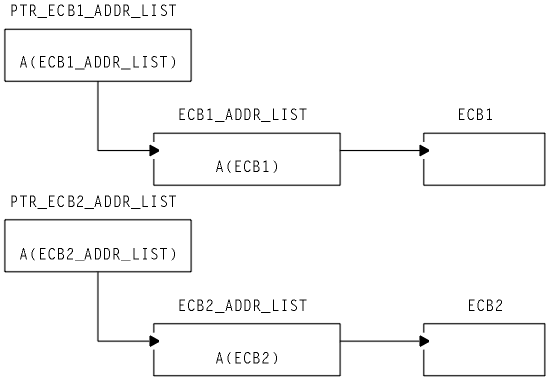If you want a resource to be accessed by two or more tasks in a specific order, instead of ENQ and DEQ commands, use one or more WAITCICS commands with one or more hand-posted ECBs.
To hand-post an ECB, a CICS® task sets a 4 byte field to either the cleared state of binary zeros, or the posted state of X'40008000'. The task can use a START command to start another task and pass the address of the ECB. The started task receives the address through a RETRIEVE command.
Either task can set the ECB or wait on it. Use the ECB to control the sequence in which the tasks access resources. Two tasks can share more than one ECB if necessary. You can extend this technique to control as many tasks as you want.
The example in Figure 1 shows how two tasks can sequentially access a temporary storage queue by using hand-posted ECBs and a WAITCICS command.
The example uses two ECBs, (ECB1 and ECB2), addressed by the pointers illustrated in Figure 2.
In theory, these tasks could exchange data through the temporary storage queue for ever. In practice, some code would be included to close down the process in an orderly way.
Task A Task B
Delete temporary storage queue
Clear ECB1 (set to X'00000000')
Clear ECB2
EXEC CICS START task B ( pass addresses EXEC CICS RETRIEVE
of PTR_ECB1_ADDR_LIST and (addresses passed)
PTR_ECB2_ADDR_LIST
LOOP: LOOP:
EXEC CICS WAITCICS Write to TS queue
ECBLIST(PTR_ECB1_ADDR_LIST) Post ECB1 (set to X'40008000)
NUMEVENTS(1) EXEC CICS WAITCICS
Clear ECB1 ECBLIST(PTR_ECB2_ADDR_LIST)
Read TS queue NUMEVENTS(1)
Process data
Delete TS queue
Write to TS queue
Post ECB2 ClearECB2
Go to start of loop Read TS queue
Process data
Delete TS queue
Go to start of loop 
Dealing with exception conditions describes how the exception conditions that can occur during processing of a task control command are handled.
